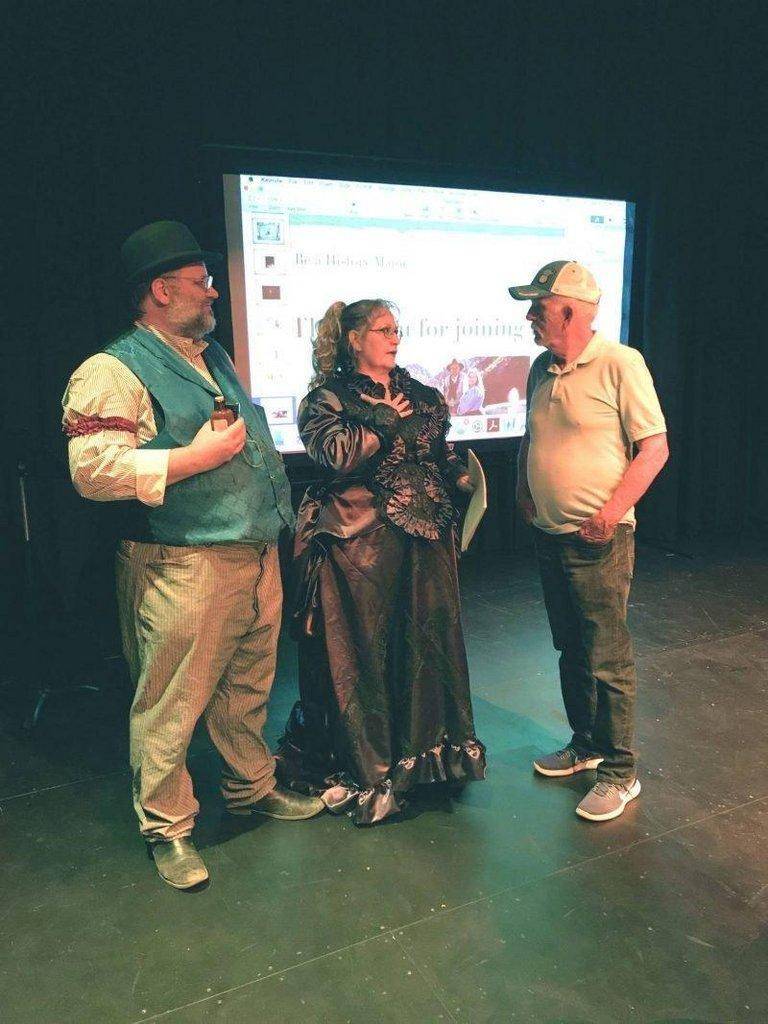USU Eastern Press Release
Stories about outlaws and murders in Carbon County were described by Darrin Teply and SueAnn Martell during the USU Eastern’s Phi Alpha Theta and History Department’s “Fright Night” event Oct. 24.
“True Stories of Murder, Mayhem, & the Macbre” was the basis of the couple’s presentation that began when they morphed into characters: Bobcat and Kitty.
The two have researched and wrote several books and articles about the colorful characters and the notorious outlaws they describe in their “historic and slightly irreverently off-of-the-wall presentations.” Their motto is “subversively teaching history… one dead body at a time,” which they usually do while wearing classic 1880’s attire.
“Our area’s history was rarely sunshine and daisies, it was often stained with bloody suffering and abuse,” Kitty said.
“Much of what quietly happened here should be in textbooks everywhere, some of the events and court cases became standards in the United States for determining corruption and tainted court proceedings,” Bobcat said.
Kitty described a twisted two-part story, dropping the names of gunfighters and outlaws like Butch Cassidy and Clarence “Gunplay” Maxwell, as well as the shady judges and attorneys, J.W. Warf and Doc Shores, that were part of Carbon County’s dark history.
Their research noted the historical saga would avalanche into men mis-identified as Butch Cassidy, who were murdered while they slept and their bodies put on display at the Price Depot. Their bodies were buried in the city dump which paralleled the cemetery. But peace didn’t come to the victims as they were dug up and re-identified multiple times, eventually the cemetery expanded to include them almost a 100 years later.
“Would you believe Butch Cassidy attended his own funeral and thought the people who attended said nice things about him that it caused Butch and Matt Warner to semi-quietly pump their stolen gold into Carbon County’s creation through Warner’s later businesses and projects,” Kitty said.
Bobcat added, “What most people don’t realize is that sections of Utah were built with the outlaws’ money and Carbon County’s dramas had a wider affect that shaped the American West to our modern day.”
Describing another dark CC example, Sheriff Marion Bliss reigned as the top law enforcement official in the county for 18 years and wanted the county to be dry, despite the repeal of the 21st Amendment. He targeted the Italians because they loved their alcohol. “All Italian women are short, smelly and hairy gorillas,” he said. Flyers were actually distributed calling for citizens to take up arms against Bliss’ tyranny. Kitty said court room transcripts, documents and personal histories provided a shocking look at the antics and attitude of law enforcement at that time.
Another favorite of the two historian “cases” involved Annie Madison Bradley who was working for the Republican Party in Salt Lake City. She was having an affair with Utah “Playboy” Sen. Arthur Brown and she ended up fatally shooting him in the crotch.
Bradley moved to Price with her two sons. She opened a store on Main Street and lived in the apartment above the store. Her older son Matt was an incredible student and started the school newspaper while he attended Carbon High School. One afternoon, her sons got in a heated fight and the younger brother, Arthur, pulled a kitchen knife and fatally stabbed his older brother.
Matt was buried in Salt Lake City and his mother relocated there after selling her store in Price which later became Lewis Jewelry. Her death certificate would claim Sen. Arthur Brown as her deceased husband. To this day the apartment upstairs where the fight took place, is filled with noises and movements.
The final story described a plaque at the entrance of a canyon north of Airport Road came to be. Two boys found a decaying body which caused a statewide search. People stated that they “could not imagine why anyone would want to live in this festering pit of swamp alkali and cactus” that later would become Carbon County. On the plaque is the name: Dead Man’s Canyon.
In between the stories, using the method of barkers of yester-year, “Dr. Bobcat – snake oil salesman,” described the glass containers recovered during Helper’s infrastructure improvements. “The disgusting liquids inside the bottles claimed that they could heal most ailments or injuries with ingredients that would make most people sick today… actually, they made people sick then too, causing the rise of the Food and Drug Administration.”
Holding up a bottle, he said its secret ingredients were nothing more than, “leather-tanning acids, even more urine, more alcohol and some dustpan sweepings.” Another child’s cold remedy was nothing more than a mixture of pine tar, honey, alcohol and chloroform.
Most of the snake oils used in the tunnels and backrooms of Helper were for the treatment of women who worked in the bordellos.
Martell and Teply own the Eastern Utah Tourism and History Association in Price. Their research can be seen on their Facebook page as “History Bites,” in their books and soon on their website at www.eutha.org. They can also be reached at (435) 630-3699.

